Essential Lawn Care Tips for Winter Preparation

We’re so close to winter, only 1 month left! And while we may be ready to kick back and be ready, there may be a few last minute preparations to ensure your lawn is in tip top shape and ready for winter.
Your lawn is an entire population of different plants. With this being said, there will be different needs for each variety of grass but for the most part are able to be treated as a whole and the best way possible. Since our biggest goal is a healthy, happy lawn come spring, it’s important that we keep maintaining unless the last possible minute.
You should continue mowing your grass until there has been no visible growth for about two weeks. The best time when to know that is when there are no clippings to remove. Remember to leave grass at least two inches, but no more than three inches for winter. This height requirement is absolutely imperative to your lawn’s health because cutting grass to short makes it vulnerable to drying winter winds and the sun. If there is no protecting snow, the winter sun can be damaging to your lawn.
Leaving your lawn at least two inches will protect the crown, which is the white area visible at ground level that will also extend into the root zone. If you allow your grass to grow too long though, the height can also cause problems.
If your lawn is too tall, the grass will lay over on itself. Bent down by too much snow, it will bring in that moisture and develop fungus and diseases such as snow mold. While too much sun or wind can be damaging, it’s important to remember your lawn needs light and air all winter.
Usually by this time of the year, the top growth of your grass has stopped growing but the root system is still going. These roots are sending out rhizomes or tillers that will sprout new blades of grass in the spring. A green plant will typically live about three years and then will be replaced by new plants from its own rhizomes.
While this is a great thing for your yard, we need to focus on another necessary task: edging the flowerbeds! Once a new grass plant grows where your flowers are, it is considered a weed. Save your time and your back some weeding time next spring by ensuring you edge all of your flowerbeds now.
Fall is a great time of the season to fertilize your lawn for the last time, especially to encourage those roots. Even if you have been keeping up with fertilizing your lawn, many of its nutrients have been taken away these past seasons so it’s important to remember to fertilize for the winter.
Look for fertilizer high in nitrogen or a winterizer-type, which is lower in nitrogen and higher in phosphorus and potassium. Taking the time to fertilize your lawn now will encourage it to have a healthy, beautiful growth for next spring.
Your lawn is always growing so make sure during the fall to keep the falling leaves raked so that they don’t gather up and suffocate your lawn’s roots. Make sure to keep raking, even after the first snowfall has melted. Leaves that lay on your lawn all winter long can prevent water from reaching the grass or trap in too much moisture, causing grasses to rot out and die by the time spring comes around.
By ensuring that you are caring for your lawn in the fall, you can encourage healthy growth in the spring. A final parting tip though: make sure you take your mower in for maintenance now. That way when everyone else is standing around in long waits for repair, you’ll be up and ready to cut and take care of your beautiful spring lawn.
